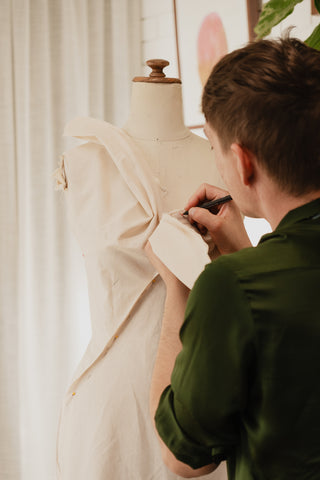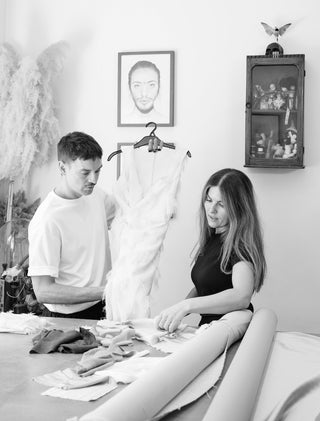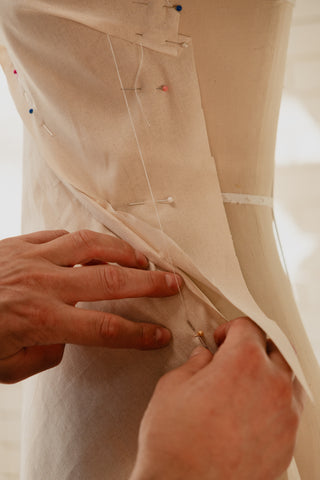
ABOUT US
One Fell Swoop isn’t just a brand; it’s a reflection of our unwavering belief in the power of design to shape how women feel, move, and experience the world. We’ve always said that a garment is more than just fabric—it’s a reflection of the wearer’s individuality, confidence, and strength. From the very beginning, our journey has been about creating something that challenges the conventional, something that breathes life into the fashion industry by celebrating women, their bodies, and the stories they tell.
Every piece we create is the result of a hands-on, intimate process that starts with an idea—a vision of how fabric can move, drape, and connect with the body in ways that feel natural and fluid. No side seams or standard patterns. Just raw, honest design, built from scratch on the mannequin, where every line and curve is a choice. It’s a method born from our belief that clothing should embrace, not constrain, the human form.
What sets One Fell Swoop apart is not just what we create, but how we create it. Our fabrics are chosen not by trend, but for their ability to stand the test of time, both in terms of durability and the way they shape to the body. We’re not about fleeting fashion. We’re about pieces that transcend seasons, made to move with you through the highs and lows of life.
We believe in transparency, in craftsmanship, and in the power of design to tell a story. Every stitch, every drape, every seam is a step in our ongoing journey to make clothing that matters—not just to the fashion industry, but to the women who wear it. One Fell Swoop is for the women who want more than just a dress. It’s for the women who want to feel something when they wear it. To feel seen, to feel alive, to feel authentic.

OUR STORY
Established in 2005 and co-designed by Nina Ergic and Dan Romanin, One Fell Swoop is an Australian womenswear label, lauded for precision drapery and proficient tailoring.
Having met while studying at the prestigious West Australian School of Art and Design, where both students would be the first in and the last to leave, they quickly discovered that not only did they share a similar European lineage, but possessed a congruent design aesthetic. And when it came time to present their final year collection, they did so together, thus beginning their venture.
In February 2005 they made their debut as One Fell Swoop, a moniker that was inspired by a critical scene from Shakespeare’s Hamlet, which resonated strongly with the designers. The inaugural 15-piece collection earned One Fell Swoop both critical and commercial success. They were soon after the Mercedes Benz Australian Fashion Week Startup Award, which allowed them to present a collection at the A/W Mercedes-Benz Fashion Week in June of 2005. The subsequent exposure secured new stockists on both the east and west coast of Australia.
During these formative years, Nina and Dan mastered their chosen mediums of tailoring and drapery. They forged signature techniques including the age-old art form of manipulating a singular piece of cloth, resulting in the creation of an interminable garment. Their minimalist silhouettes are designed to complement both the female form and the environment in which they are worn.
Having cemented their position within the Australian market. One Fell Swoop are featured in publications such as Vogue Australia, Marie Claire and Stellar Magazine. The brand has also become a go-to for red carpet favourites Jules Sebastian, Lindy Klim and Anna Heinrich.

OUR DESIGN PROCESS
At One Fell Swoop, our design process is driven by an exploration of shape, form, and movement. We don’t follow a standard block or traditional pattern-making methods. Instead, we start by experimenting with different draping techniques, often working directly on the mannequin with calico. This hands-on approach allows us to sculpt and shape each garment from scratch, creating a fit that’s uniquely tailored to the body rather than confined by the rigidity of pre-made blocks or patterns.
1. The Foundation: Toiling & Draping
The design journey begins with an exploration of silhouettes and techniques that excite us. We don’t limit ourselves to one approach but rather experiment with various draping techniques that bring different elements into focus. Each piece evolves organically, often using long, fluid pieces of fabric to create shapes that embrace the body’s natural curves. This process allows us to create dynamic, sculptural designs that feel alive and connected to the wearer, rather than stiff or overly structured.
2. Shaping the Design: Pinning, Wrapping, and Sculpting
As we develop the silhouette, we experiment with pinning fabric into place, wrapping it across the body, and creating tension where it’s needed. By wrapping the fabric around the torso or hips, we establish key elements like the neckline, waist seam, and back shape. The fabric is manipulated, twisted, and shaped to emphasise curves and create balance. We balance the tension and flow of the fabric to bring the design into harmony, giving it both structure and fluidity.
3. Perfecting the Fit: Fine-tuning & Control
Once the draped silhouette is in place, we refine the fit by adding seams that give us more control over the excess fabric, particularly around the waist, back, and shoulders. These seams help us sculpt the design to better fit the body, allowing for more precision in areas that need it, such as the back panel or shoulder seams. We may also incorporate elements like side seams or subtle shaping lines that ensure the garment fits organically, without disrupting the overall aesthetic.
4. Translating to Paper: Creating the Pattern
Once the draped form feels complete, the next step is to translate it into a pattern. We carefully unpick the calico toile, trace each piece onto paper, and preserve all the details—seams, grain lines, and measurements. The pattern is checked to ensure the design retains its organic shape and proportions. This step is particularly crucial for garments with bias grains, curved necklines, or other non-standard design elements, as we take great care to ensure the pieces hold their shape during construction.
5. Fabric Selection & Sampling
With the pattern in hand, we move on to fabric selection. Each fabric is chosen not just for its visual appeal but for its ability to enhance the movement and fit of the garment. We test different fabrics, considering their drape, stretch, and handle, ensuring they align with the vision we’ve developed. The first sample is made, and we try it on various body shapes to ensure the design works seamlessly for all figures. Further adjustments are made as needed to perfect the fit and flow of the garment.
6. Final Construction & Quality Control
The design process culminates in the final construction of the garment, where every detail is carefully executed. We work closely with our local production team to ensure that the craftsmanship meets our high standards, and we conduct thorough quality control checks to make sure every piece is perfect. Each garment is a testament to the time, care, and expertise that goes into creating something that feels as beautiful as it looks.




